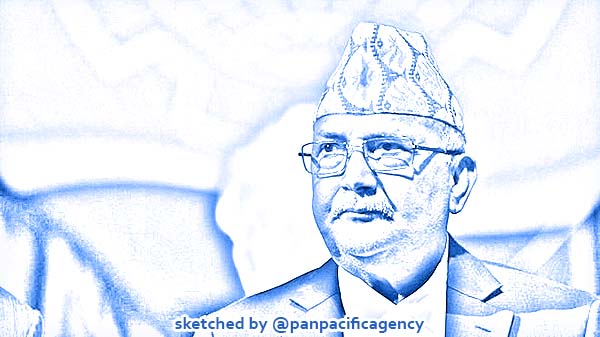[Analytics] A reflection on Nepal’s path to a republic

Prime Minister of Nepal, K P Sharma Oli (Source: nepal24hours). Sketched by the Pan Pacific Agency.
In its first sitting in May 2008, the elected Constituent Assembly (CA) of Nepal formally abolished the monarchy and declared the country a secular federal republican state. Pawan K Sen specially for the East Asia Forum.
The decision was ratified through the promulgation of the country’s new constitution in September 2015 by an overwhelming majority — almost 91 per cent — of the elected CA members. There is however still a question around whether Nepal’s political parties made decisions on state restructuring based on majority public will or at their own discretion.
In a diverse country like Nepal — sharply divided along ethnic, religious, linguistic and cultural lines — a majoritarian approach to forming a democracy could have created a situation that legally allowed the preferences of the majority to overwhelm the rights of minorities.
According to a number of public opinion polls in the run up to 2008, most preferred that Nepal remain a Hindu monarchical state, indifferent about the issue of federalism just four months out from the May 2008 declaration. The majority also wanted to retain the Nepali language as the country’s only official language.
The minority who supported a republican, secular state and multi-linguistic policy was substantial and, at some sub-national levels, even in the majority. The agenda of republicanism held up to the majority of the hill caste group. And on the issue of secularism, the majority of hill indigenous groups and non-Hindu people wanted to see Nepal as a secular state.
People of hill and Madhesi (lowland) origin were divided on the issue of language. The majority of people of hill origin supported the Nepali language as the only official language. But the majority of Madhesi people wanted to curb the domination of the Nepali language and demanded a multi-linguistic policy. Madhes-based parties opposed state policy of one language from the start, arguing that it suppressed other languages.
All the major political parties supported federalism, republicanism, secularism and multilingualism at the time of the May 2008 declaration. These state-structures ended up formalised in Nepal’s new constitution.
Time-series data on public opinion shows substantial gaps between the political parties’ positions and public preference on constitutional changes at the time. But after the May 2008 declaration, declining popularity of the monarchy and a falling perception of its divinity translated into gradually lower popular support. By April 2012, public opinion had evolved. Supporters of a republican state formed a simple majority, but voters still preferred a Hindu state and favoured Nepali as the only official language.
Two important political events should be highlighted. First, the mass protest movement of April 2006, which was the outcome of the 12-point Memorandum of Understanding between the parliamentarian political parties and the Communist Party of Nepal (CPN-Maoist). And second, the May 2008 declaration of the elected CA.
As per the 12-point MoU, the political parties called a nationwide mass protest movement on 6 April 2006 — supported by the CPN-Maoists — against Nepal’s autocratic monarchy. The major political parties and the CPN-Maoists had a clear-cut plan about what to do with the old structures of the Nepali state after the successful end of the movement.
Major political parties like the Nepali Congress and the CPN (Unified Marxist-Leninist) — the other major communist party in Nepal — already had common consensus with the CPN-Maoists to side-line the king, abolish the monarchy and declare the country a republic.
Such a consensus saw Nepal declared a federal, secular and republican state by the first sitting of the CA held on 28 May 2008. This declaration was momentous, through which the process of the state’s structural political transformation formally began.
The CA members took these decisions on behalf of their constituencies, instead of taking the issue to a referendum. The new structure of the Nepali state was decisively redesigned at the discretion of the political parties, not explicitly by majority preferences of the public.
If decisions are made based simply on the preferences of the majority, there is a high chance of minorities being disadvantaged. The preferences of minorities can be suppressed under the weight of the majority. This means that democratic processes can produce laws oppressive to minority rights. Some political scientists say that the simple standard majoritarian approach is largely unable to provide representation and safeguard the vital interests of minorities and disadvantaged groups.
Nepal was able to issue the new constitution in September 2015 because the country’s political parties took a consensus not majoritarian approach. This helped prevent the tyranny of the majority and misuse of democracy against minorities. By adopting a consensus approach through the CA, the major political actors proved themselves defenders of political tolerance and minority rights.
It was a start. Yet a comprehensive consensus that protects Nepal’s minorities is still to be fully realised. Madhes-based political parties questioned the provision of citizenship, the right to employment in state structures and the delimitation of constituencies immediately after the promulgation of the new constitution. They called for mass demonstrations and declared a border blockade in the Tarai that went on until February 2016, when the Constitution was amended to meet some demands. Disagreements, including over the provision of citizenship, remain to this day.
Nevertheless, through a most difficult era in Nepal’s political history, it is remarkable that the CA members steered the country’s complete political overhaul and restructuring through consensus and not by plebiscite.
Pawan K Sen is Director of Himalaya Comprehensive Research, Kathmandu, and a PhD scholar at Leiden University.